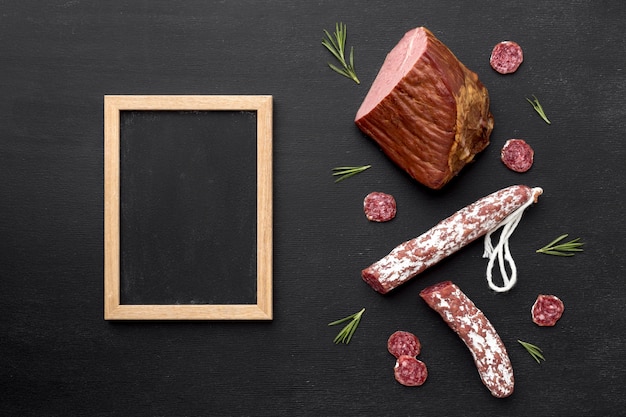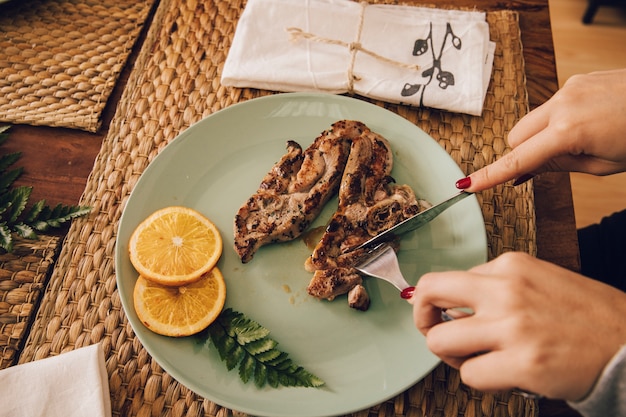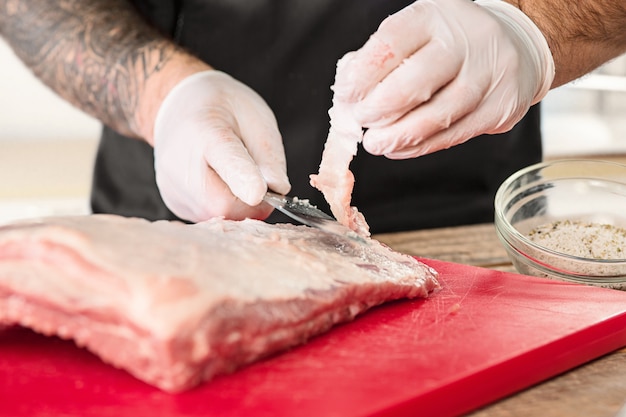You've got your brisket in the smoker, its aroma filling the air with promises of juicy, smoky deliciousness. Hours have passed, and you're starting to think about pulling it off, carving it up, and digging in. But then, the question pops up, and it's a doozy: how long do you cook it after wrapping in foil? I've been there, friend. It's a common dilemma, and the truth is, there's no one-size-fits-all answer. It's a bit like finding the perfect cup of tea – a matter of personal preference and knowing your brisket.
(Part 1) The Science of brisket wrapping

Let's rewind a bit and talk about why we wrap brisket in the first place. Think of it as giving your brisket a little culinary hug. Wrapping it in foil creates a steamy environment, which works wonders for your meat:
- Tenderizing the Meat:
That steam inside the foil traps moisture and heat, working its magic on the tough connective tissues in the brisket. These tissues break down, making the meat melt-in-your-mouth tender. It's like a slow, gentle massage for your brisket, transforming it into a culinary masterpiece.
- Developing a Bark:
Before wrapping, the exposed brisket is free to develop a beautiful, crispy bark. That's the glorious outer layer that gives your brisket a satisfying crunch. Wrapping allows this bark to set while the meat inside cooks to perfection. Think of it as a protective shield, keeping the bark from getting soggy and ensuring a delightful textural contrast.
- Preventing Over-Drying:
Brisket is a lean cut, and without the foil's moisture barrier, it can dry out during the long cooking process. Wrapping acts like a little raincoat for your brisket, retaining its natural juices and keeping it moist and flavorful. It's like giving your brisket a little drink of water in the middle of its long journey to deliciousness.
(Part 2) The Art of Timing: Finding the Sweet Spot

Now, for the million-dollar question: how long to cook after wrapping? This is where the art comes in, and it's all about understanding the factors that influence the perfect wrap time:
- Brisket Size:
A smaller brisket will need less time to cook than a larger one. Think of it like baking a cake - a smaller cake needs less time to bake than a larger one. The internal temperature is your guide, so keep a close eye on that.
- Smoker Temperature:
Lower temperatures require a longer cooking time. Higher temperatures will cook your brisket faster, but you'll need to be careful not to overcook it. It's like driving a car - if you drive slowly, it will take longer to reach your destination.
- Brisket Fat Content:
A brisket with more fat will take longer to cook because the fat needs more time to render. Think of it as a marathon - if you have more energy reserves (fat), you can run for longer.
- Desired Tenderness:
Do you crave a melt-in-your-mouth brisket or one with a bit more chew? Your desired tenderness influences the cooking time after wrapping. It's like cooking pasta - some like it al dente, while others prefer it soft. It's all about personal preference!
(Part 3) The Tell-Tale Signs: Knowing When It's Ready

The truth is, there's no single number that guarantees a perfect brisket. But, there are tell-tale signs that your brisket is ready to be unwrapped and devoured:
- Internal Temperature:
This is the most reliable indicator. Aim for an internal temperature of 195-205 degrees Fahrenheit (90-96 degrees Celsius) for a truly tender brisket. Think of it as a thermometer for your brisket – it gives you a precise reading of its readiness.
- Probe Tenderness:
The brisket should feel incredibly tender when you poke it with a meat thermometer or probe. It should give way easily, like a marshmallow. This is a great way to test its texture without having to cut into it.
- Visual Clues:
The brisket should have a nice, even bark that's slightly firm to the touch. The fat should be rendered, leaving the brisket with a lovely glistening surface. It's like a visual feast for your eyes, signaling that it's time to tuck in.
(Part 4) The Art of Unwrapping and Resting
Once you've achieved the desired tenderness, it's time to carefully unwrap your brisket. Here's the deal - don't rush this part. The brisket needs a chance to rest and settle, retaining its moisture and allowing the juices to redistribute. Think of it as a little spa day for your brisket, letting it relax and unwind after its long journey in the smoker.
- Unwrapping Carefully:
Gently lift the foil and let the steam escape slowly. Don't be tempted to peek too early! This is a moment of anticipation, letting the aroma waft up and tantalize your senses.
- Resting Time:
Let your brisket rest for at least 30 minutes, ideally wrapped in foil. This allows the meat to redistribute its juices and become even more tender and flavorful. Think of it as a little nap for your brisket, allowing it to soak up all the deliciousness.
- Serving with Style:
Once your brisket has rested, you can carve it into slices or pull it apart with forks. Serve it with your favorite sides – bbq sauce, coleslaw, potato salad, or baked beans – and enjoy the fruits of your labor. This is the moment you've been waiting for, the culmination of all your hard work.
(Part 5) The Wrap-Up: A Few Tips to Remember
Here's a quick cheat sheet to help you navigate the world of brisket wrapping:
- Foil or Butcher Paper?
Both foil and butcher paper are excellent choices for wrapping brisket. Foil creates a tighter seal, which helps to trap moisture and heat. Butcher paper, on the other hand, is more breathable, allowing for some evaporation. Ultimately, the choice is yours. I usually use foil, but I've heard great things about butcher paper too. Experiment and see what you prefer!
- The Importance of Liquid:
Don't forget to add a splash of liquid to the foil packet. This could be beef broth, apple cider, or even just water. It helps keep the brisket moist and tender while it finishes cooking. Think of it as a little drink of water to quench the brisket's thirst.
- Don't Overcook It:
It's easy to get carried away with the cooking process, but remember that overcooking can make the brisket dry and tough. Pay attention to the signs and don't be afraid to pull it off the smoker early if needed. It's better to err on the side of caution than to risk ruining your masterpiece.
(Part 6) The Verdict: A Recipe for Success
I've spent countless hours perfecting my brisket recipe, and I've learned a few things along the way. Here's a simple, yet effective recipe for a juicy, tender brisket:
- Ingredients:
- 1 brisket (about 10-12 pounds)
- Your favorite BBQ rub
- 1 cup beef broth
- Optional: Apple cider or beer
- Instructions:
- Trim the brisket of excess fat and rub it all over with your favorite BBQ rub. The rub will add flavor and a beautiful crust to your brisket.
- Place the brisket fat-side up on your smoker and cook at 225 degrees Fahrenheit (107 degrees Celsius) for 4-6 hours, or until the internal temperature reaches 160 degrees Fahrenheit (71 degrees Celsius). The low and slow cooking method is key to breaking down the tough connective tissues and creating a tender and flavorful brisket.
- Wrap the brisket tightly in foil, adding 1 cup of beef broth, apple cider, or beer. The liquid will help create a moist environment and prevent the brisket from drying out during the final cooking stage.
- Continue cooking until the internal temperature reaches 195-205 degrees Fahrenheit (90-96 degrees Celsius). This is the sweet spot for a tender and juicy brisket. Be patient, the final stages of cooking are crucial to achieving that perfect texture.
- Remove the brisket from the smoker and let it rest for at least 30 minutes before carving and serving. Resting allows the juices to redistribute throughout the brisket, making it even more tender and flavorful. It's an essential step in the process, so don't skip it!
(Part 7) The Takeaway: Embrace the Journey
Mastering brisket is a journey. It takes time, patience, and a little bit of trial and error. But don't get discouraged! Every brisket you cook is a learning experience. Embrace the process, experiment with different techniques, and most importantly, enjoy the delicious journey. And remember, the best brisket is the one you made yourself, with love and care.
(Part 8) FAQs: Answering Your Burning Questions
Here are some common questions about brisket wrap time:
- How long should I cook my brisket after wrapping?
There is no magic number. The ideal wrap time depends on the brisket size, smoker temperature, fat content, and desired tenderness. Use a meat thermometer to check the internal temperature and look for visual cues to determine when it's ready. Remember, it's better to err on the side of caution than overcook it.
- What happens if I wrap my brisket too early?
If you wrap your brisket too early, it may not reach the desired tenderness and might develop a soggy bark. It's better to wait until the internal temperature is around 160 degrees Fahrenheit (71 degrees Celsius) before wrapping. This allows the meat to develop a nice, firm bark before you trap the moisture in with the foil.
- Can I wrap my brisket in butcher paper?
Yes, you can wrap your brisket in butcher paper. It's a great alternative to foil and can result in a drier bark. The choice is really up to you, but it’s worth experimenting with both options to see which you prefer.
- What temperature should I cook my brisket at?
The ideal smoking temperature for brisket is between 225-250 degrees Fahrenheit (107-121 degrees Celsius). Lower temperatures promote a more tender brisket, but the cooking time will be longer.
- How long does it take to cook a brisket?
The cooking time for a brisket varies depending on its size and the smoker temperature, but it generally takes 12-16 hours. Be patient, it’s a marathon, not a sprint!
Good luck, my friends, and happy brisket-ing!
Everyone is watching

How to Cook Frozen Lobster Tails Perfectly: A Step-by-Step Guide
RecipesLobster. Just the word conjures up images of lavish meals, special occasions, and a taste of luxury. But let's...

Pigs in a Blanket Cooking Time: How Long to Bake for Perfect Results
RecipesAh, pigs in a blanket. Just the name conjures up images of those delightful little parcels of crispy pastry en...

Pork Fillet Cooking Time: How Long to Cook It Perfectly
RecipesPork fillet, or tenderloin as it's sometimes called, is a real favourite in our house. It's so versatile, and...

The Ultimate Guide to Cooking Sweet Potatoes: From Roasting to Mashing
RecipesSweet potatoes. Just the name conjures up images of warm, comforting dishes, bursts of vibrant color, and a to...

The Ultimate Guide to Tender, Juicy Pulled Pork
RecipesRight, let's talk pulled pork. It's one of those dishes that just screams "comfort food," doesn't it? I mean...
